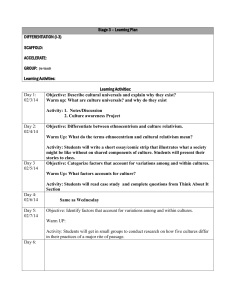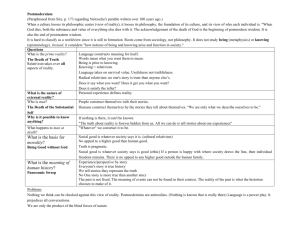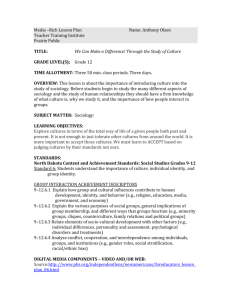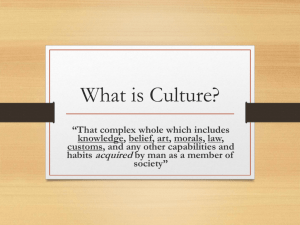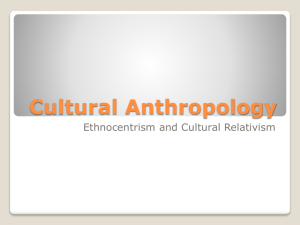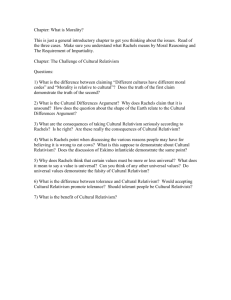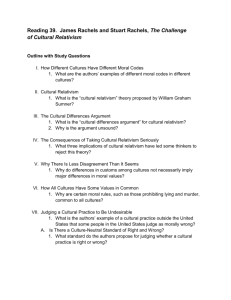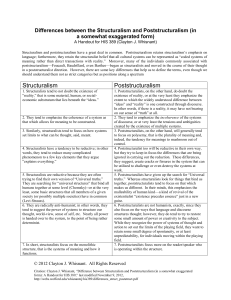Introduction to Cultural Studies
advertisement
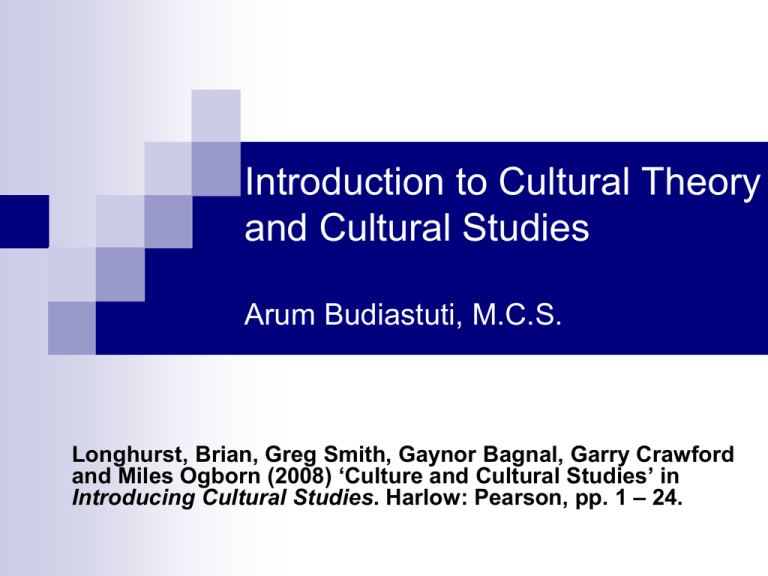
Introduction to Cultural Theory and Cultural Studies Arum Budiastuti, M.C.S. Longhurst, Brian, Greg Smith, Gaynor Bagnal, Garry Crawford and Miles Ogborn (2008) ‘Culture and Cultural Studies’ in Introducing Cultural Studies. Harlow: Pearson, pp. 1 – 24. Culture: Definitions According to Raymond Williams (one of the founder of Cultural Studies) three uses of the term culture: as artistic activity ex. engaging in music, literature, theatre, film, painting as way of life (anthropology and some schools of sociology) constructing meaning of symbols of particular way of life/signifying practices. Ex. to study culture is to study the meaning of a style of dress, a norm, a language, etc. In this sense, however, the definition must be distinguished from the concept of society. Society refers to the pattern of social interactions and relationships between individuals and groups, and creates culture(s). as a process of development (History) ex. involves historical process Illustration Rock and Roll may be analized: - by the skill of the performers (artistic activity) - by its association with youth culture (way of life) - As a musical form which is originated from older music form and influences later music forms (historical process) “Cultural Studies approach facilitates the identification of core issues or problems that no one discipline or approach can solve on its own”. Therefore, the nature of cultural studies is interdisciplinary. How do people become part of a culture? acculturation/enculturation Anthropology conditioning Psychology, ex. psychoanalysis socialization Sociology All concepts above pay attention on various social arrangements in how humans learn about meaning. The core issue of cultural studies is the interpretation of meaning, and it involves issues of evidence and relativism. How does Cultural Studies interpret what things mean? Anthropologists see culture as shared understandings and groupings in society Sociologists, ex. Berger and Luckmann (1966) Human knowledge of the world is socially constructed, or through social location (age, gender, race, class) and interaction with other people. If so, we only see the world from certain angles relativism. Conclusion: There’s no true knowledge. Therefore, interpretation of meaning is a core issue of Cultural Studies, and it relates to how we understand the past and present. Historical Relativism In terms of past and present, there is tradition, which is not objective, but culturally constructed (means that some things are included and some others are excluded). Ex: 1. English written tradition: poem, prose canon and non-canon, high culture. Low culture Ex. Shakespeare, Puccini’s/Pavarotti’s Nessun Dorma 2. Scottish traditional costume, Kilt, was significant for the Highlands but then was taken over by the lowlands as distinctive feature. So, its meaning is constantly changing in Scottish society. Scottish Kilts: Then and Now Cultural Relativism Interpretation of cultures from different parts of the world or different sections of our own society. Ex: interpret non-European culture and between man and women. Hollis and Lukes (1982) put both historical and cultural relativism under ‘perceptual relativism’: the degree to which perception is relative, i.e. when we look at something, do we actually see the same thing as another person looking at it?; Conclusion: in studying culture, we must think about who we are, where we come from, and what our position is, to understand who and what we study. Example: Interpreting Pitchard’s Nessun Dorma Further issue of perceiving or valuing culture Due to cultural and historical relativism, there are notions of ‘high culture’ and ‘popular/mass culture’. This question of boundaries between levels of culture and the justification is an area of central concern for cultural studies. Thus studies of the processes of boundary maintainance and change are issues of cultural change and continuity (culture as a process of development). These issues and concerns in cultural relativism introduces a strong aspect in culture: power. How do we understand the relationship between cultures? The conventional way of studying culture is to see cultures as mutually exclusive blocs that interact along a boundary or ‘zone of contact’ often desribes the relationship in terms of ‘destruction’ or ‘corrupts’ another, for ex. through the process of colonialism or globalisation. Weaknesses (according to the author): 1. We’ll face not only one culture in one ‘territory’ but many, since culture is also a matter of class, age, gender, status. 2. It does not operate simply in terms of stronger cultures destroying weaker ones. Because culture is a never-ending process of socially made meaning, it adapt, change and mutate into new forms hybridation. Culture and Power Since culture is a product of interaction and part of social world, it is shaped by significant line of force that operates in the social world. All societies is organised politically and economically, and these arrangements produce certain social formation. The interests of dominant groups in society affect cultures. One way is through construction of tradition and the its distribution through the population. Another view is that the dominant group uses mass culture to drug subordinate groups (propaganda theory). Whatever view employed, culture is always linked with politics and power relations. This relation is also a fruitful area of cultural investigation. How is ‘culture as power’ negotiated and resisted? Due to different interests in society, there will be negotiation and resistance. Four areas of struggle and negotiation that concern cultural studies are around gender, race, class, and age. Ex. Gender definitions and relations are never fixed and it becomes the product of power struggle. These struggle and resistance from the ‘subordinated’ groups often disturb the dominant ones since it is a threat to their domination. How does culture shape who we are? Struggle and negotiation above are often around questions of cultural identity. Identity is very often connected to place both locally or widely. This serves as important issue in the study of culture, in which identities are constructed and how they reflect particular distribution of power. Next, how do we address these cultural issues and phenomena? Theorising Culture Theories of culture tries to address the issues and problems and to unite them within framework of explanation. Therefore, theorising needs abstraction and looks for connections in terms of general principle or concepts. The main features of some leading theoretical approaches in cultural studies are: 1. functionalism and structuralism 2. poststructuralism or posmodernism Functionalism and Structuralism Functionalists argue that culture functions as solution to problems of social order because it contains values, the sahed ideas about what is desirable in society. Culture ‘oils the wheels’ as it also maintains economy and political system. More info: http://en.wikipedia.org/wiki/Structural_functionalism Structuralists believe that a phenomenon studied should be seen as consisting of a system of structure. The system and the relationship between different elements are more important than the individual element making up the the system. According to Allison Assiter, there are four ideas regarding structuralism: 1) the structure determines the position of each element of a whole; 2) believe that every system has a structure; 3) interested in the structural laws dealing with coexistence rather than changes; and 4) structures are the 'real things' that lie beneath the surface or the appearance of meaning. More info: http://en.wikipedia.org/wiki/Structuralism Poststructuralism It emerges as a response on binary definitions developed from structuralism. Poststructuralism often works with the way in which versions of truth are produced in texts and through interpretation, which is always in dispute. Unlike structuralism which tends to find the real structure or ‘truth’, poststructuralism tends to be more playful in practice, not outcome. Social structure and social conflicts: class, gender and race There are theorists who believe that culture is a product of social conflict. While Marxists see social conflict between classes, feminists see gender relation as an unjust system. In this view, society is structured by the dominant group, legitimizing inequality. Thus cultural domination is an essential element of economic and political control. However, culture need not be seen as dependent upon social structure, but it also can shape social structure. Max Weber, for ex., showed that the beliefs of the early Protestant sects played a key causal role in the establishment of capitalism. His intention was to show how ideas can be ‘effective’ forces in the historical development of societies (Weber, 1930:183). Foucault presents a more interwoven view of relationship between culture and society. In his notion of ‘discourse’, he argues that social groups, identities, and positions or any other cultural meanings are produced within discourses. So, there is a flexible set of relationship between power, discourse, and what exist in the world. Conclusion Cultural studies is an ‘inter-discursive space’, which substance and methods are constituted from the collaboration of disciplines around the topic of culture. There are no fixed boundaries in the study. Its strength lies in its openness so that it may transform and grow. There are three main models of research in Cultural Studies: 1. production-based studies, involves the process and struggle over the production of cultural items; 2. text-based studies, investigates the forms of cultural products; and 3. studies of lived cultures, concerned with how experience is presented. Cultural studies is an area of activity that grows from interaction and collaboration to produce issues and themes that are new and challenging.

